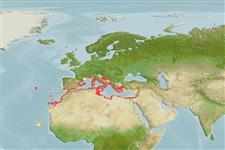Common names from other countries
Environment: milieu / climate zone / depth range / distribution range
Ecologia
marino; distribuzione batimetrica 0 - 100 m. Tropical; 44°N - 14°N, 26°W - 36°E
Eastern Central Atlantic: Cape Verde and the Canary Islands. Also reported from Lebanon in the eastern Mediterranean. Its exact distribution and abundance are unknown because most published records do not separate it from Sphyraena sphyraena. Also in Azores Islands (Ref. 44330).
Size / Peso / Age
Maturity: Lm ? range ? - ? cm
Max length : 128 cm FL maschio/sesso non determinato; (Ref. 40637); common length : 40.0 cm SL maschio/sesso non determinato; (Ref. 11101); peso massimo pubblicato: 8.2 kg (Ref. 40637)
Short description
Chiavi di identificazione | Morfologia | Morfometria
Body slender, fusiform with conical, hydrodynamical snout. Mouth long, with low protractile capacity and with prognatic lower jaw, has two rows of long canine-like teeth. Has no scale on preoperculum. Upper half of body has numerous vertical dark bands extending below the lateral line in the anterior part of the flanks (Ref. 44330).
Its habits are probably similar to those of the phylogenetically closely related Sphyraena sphyraena (Ref. 6949). Feeds on cephalopods, crustaceans and fishes. Caught in trammel nets and beach seines (Ref. 11101).
Life cycle and mating behavior
Maturities | Riproduzione | Spawnings | Egg(s) | Fecundities | Larve
De Sylva, D.P., 1990. Sphyraenidae. p. 860-864. In J.C. Quero, J.C. Hureau, C. Karrer, A. Post and L. Saldanha (eds.) Check-list of the fishes of the eastern tropical Atlantic (CLOFETA). JNICT, Lisbon; SEI, Paris; and UNESCO, Paris. Vol. 2. (Ref. 6949)
IUCN Red List Status (Ref. 130435)
CITES (Ref. 128078)
Not Evaluated
Threat to humans
Harmless
Human uses
Pesca: commerciale
Strumenti
Special reports
Download XML
Fonti Internet
Estimates based on models
Preferred temperature (Ref.
115969): 15.09 - 21.5475, mean 18.83 (based on 230 cells).
Phylogenetic diversity index (Ref.
82804): PD
50 = 0.5000 [Uniqueness, from 0.5 = low to 2.0 = high].
Bayesian length-weight: a=0.00724 (0.00339 - 0.01546), b=2.92 (2.74 - 3.10), in cm Total Length, based on LWR estimates for this Genus-body shape (Ref.
93245).
Trophic level (Ref.
69278): 4.3 ±0.5 se; based on diet studies.
Resilienza (Ref.
120179): Molto basso, tempo minimo di raddoppiamento della popolazione più di 14 anni (Preliminary K or Fecundity.).
Fishing Vulnerability (Ref.
59153): High to very high vulnerability (69 of 100).
